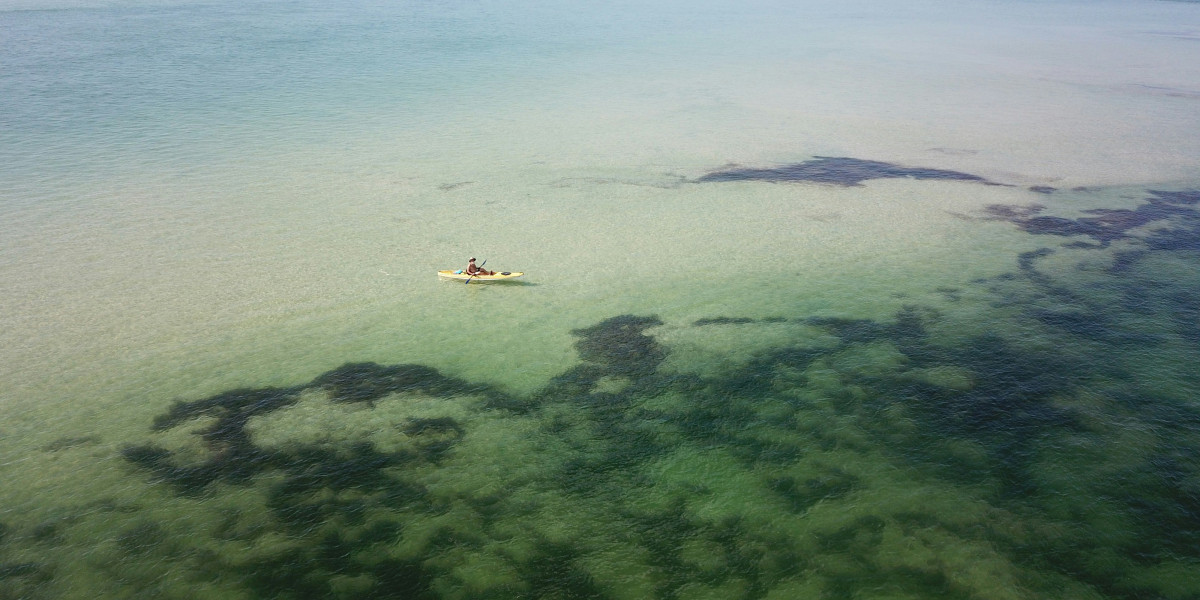Are you eager to explore waterways with a companion? Tandem kayaking might be just what you're looking for! A tandem kayak, often called a double kayak, is crafted for two paddlers to navigate together. This design makes it an excellent choice for those who prefer company during their aquatic journeys.
Whether you're an experienced paddler or just starting out, tandem kayaking presents an opportunity to bond with your partner while enjoying the great outdoors. It's a fantastic way to share the experience of gliding through water, taking in scenic views, and creating lasting memories together.
So why not grab a paddle, hop into a tandem kayak, and embark on your next water adventure? The possibilities are endless, and the experiences are sure to be unforgettable.
Types of Tandem Kayaks
When selecting a tandem kayak, you'll discover a variety of options to suit different preferences and adventure styles. These versatile watercraft come in various designs, each offering unique features to enhance your paddling experience. From sit-on-top models to sit-inside versions, tandem kayaks are engineered to provide stability and comfort for two paddlers.
Let's explore some common types of tandem kayaks to help you understand which might be best for your needs:
Sit-On-Top vs Sit-Inside Kayaks
Sit-on-top and sit-inside kayaks are two primary categories of tandem kayaks, each with distinct characteristics:
Feature | Sit-On-Top Tandem Kayaks | Sit-Inside Tandem Kayaks |
Design | Open deck design, similar to a SUP, allowing easy entry and exit | Enclosed cockpit providing a snug fit for paddlers |
Stability | Generally more stable on calm waters, ideal for beginners | Lower center of gravity offers better stability in rougher conditions |
Comfort | Freedom to move around, perfect for warm-weather paddling | Better protection from wind and water, suitable for cooler environments |
Storage | Limited dry storage but easy access to gear | More dry storage options, though accessing gear requires planning |
Water Exposure | Expect to get splashed, great for hot days | Keeps you drier, with the option to use a sprayskirt |
Ease of Use | Simple to use, great for casual paddling and quick trips | Requires more skill to enter and exit, better for longer, technical trips |
Recreational vs Touring Tandem Kayaks
Recreational and touring tandem kayaks cater to different paddling styles and preferences:
Feature | Recreational Tandem Kayaks | Touring Tandem Kayaks |
Purpose | Designed for casual paddling and short trips on calm waters | Built for long-distance travel and open-water expeditions |
Design | Shorter and wider for increased stability and ease of use | Longer and narrower for better speed and tracking |
Storage | Limited storage, suitable for day trips and minimal gear | Ample storage with multiple compartments for camping gear and supplies |
Maneuverability | Easier to turn and control, ideal for beginners and leisurely outings | Less maneuverable due to length, but excellent for maintaining a straight course |
Comfort | Larger cockpit openings for easy entry and exit, prioritizing comfort | Smaller cockpit openings for better control and protection from elements |
Performance | Slower, prioritizes stability over speed | Faster, designed for efficient paddling over long distances |
Cost | Generally more affordable, making them accessible for casual paddlers | Typically more expensive due to advanced features and materials |
Benefits of Tandem Kayaking
Tandem kayaking offers a unique set of advantages that make it an appealing option for many water enthusiasts. Here are some key benefits to consider:
Shared Experience: Paddling together allows you to share the joys and challenges of kayaking with a partner. It's an excellent way to bond and create lasting memories.
Improved Stability: Tandem kayaks are often more stable than single kayaks due to their larger size and weight distribution. This can be particularly reassuring for beginners or those who feel less confident on the water.
Increased Power: With two paddlers, you can generate more power and cover longer distances with less individual effort. This can be especially beneficial when facing headwinds or currents.
Learning Opportunity: For novice paddlers, tandem kayaking provides a chance to learn from a more experienced partner. It's an excellent way to build skills and confidence on the water.
Cost-Effective: Investing in one tandem kayak can be more economical than purchasing two single kayaks, making it a budget-friendly option for couples or families.
Versatility: Many tandem kayaks can be paddled solo if needed, offering flexibility for different situations.
Increased Gear Capacity: Tandem kayaks typically offer more storage space, allowing you to bring along more gear for longer trips or camping adventures.
Choosing the Right Tandem Kayak
Selecting the perfect tandem kayak involves considering various factors to ensure it meets your specific needs and preferences. Here are some key aspects to keep in mind:
Intended Use: Think about where and how you plan to use your kayak. Will you be paddling on calm lakes, rivers, or venturing into coastal waters? Your intended use will influence the type of kayak that's best suited for you.
Skill Level: Consider both your and your partner's kayaking experience. Some tandem kayaks are more beginner-friendly, while others are designed for experienced paddlers.
Storage and Transport: Think about how you'll store and transport your kayak. Inflatable tandem kayaks can be a great option if you have limited storage space or a small vehicle.
Weight Capacity: Ensure the kayak can comfortably support the combined weight of both paddlers and your gear.
Comfort Features: Look for kayaks with adjustable seats, footrests, and ample legroom to ensure a comfortable experience for both paddlers.
Budget: Tandem kayaks come in a wide range of prices. Determine your budget beforehand, but remember that investing in a quality kayak can enhance your overall experience and potentially save money in the long run.
Material: Kayaks can be made from various materials, including plastic, fiberglass, and inflatable materials. Each has its own pros and cons in terms of durability, weight, and performance.
Brand Reputation: Research reputable brands and read customer reviews to get a sense of the kayak's quality and performance.
By carefully considering these factors, you'll be better equipped to choose a tandem kayak that aligns with your needs and enhances your paddling adventures.
Tips for Tandem Kayaking
Mastering the art of tandem kayaking can greatly enhance your experience on the water. Here are some valuable tips to help you and your partner paddle in harmony:
Communicate Clearly: Establish clear communication with your partner before and during your kayaking trip. Agree on basic commands and signals to coordinate your movements effectively.
Sync Your Strokes: Try to paddle in rhythm with your partner. The person in the back should follow the lead of the front paddler to maintain a steady pace and direction.
Balance the Weight: Distribute weight evenly in the kayak for optimal stability and performance. Heavier items should be placed low and centered in the kayak.
Practice Entering and Exiting: Spend some time practicing how to get in and out of your tandem kayak safely. This can be particularly important for sit-inside models.
Assign Roles: Decide who will be responsible for steering (usually the person in the back) and who will set the pace (typically the person in front).
Start with Shorter Trips: If you're new to tandem kayaking, begin with shorter outings to build your skills and confidence before tackling longer adventures.
Be Patient: It may take some time to find your rhythm as a team. Be patient with each other and remember that practice makes perfect.
Safety First: Always wear personal flotation devices (PFDs) and bring essential safety gear, including a whistle, first aid kit, and appropriate clothing for the conditions.
Learn Basic Rescue Techniques: Familiarize yourselves with basic rescue procedures, such as how to handle a capsize situation.
Enjoy the Journey: Remember to have fun and enjoy the shared experience of exploring the water together.
Maintenance and Care for Your Tandem Kayak
Proper maintenance and care of your tandem kayak will ensure its longevity and optimal performance. Follow these guidelines to keep your kayak in top condition:
Rinse After Use: Always rinse your kayak with fresh water after each use, especially if you've been paddling in saltwater. This helps prevent corrosion and removes any debris.
Dry Thoroughly: Allow your kayak to dry completely before storing it. This prevents the growth of mold and mildew.
Store Properly: Store your kayak in a cool, dry place out of direct sunlight. If possible, store it on its side or suspended to prevent deformation.
Inspect Regularly: Regularly check your kayak for any signs of damage, such as cracks or holes. Address any issues promptly to prevent further damage.
Protect from UV Rays: If your kayak is stored outdoors, consider using a UV-resistant cover to protect it from sun damage.
Lubricate Moving Parts: Keep any moving parts, such as rudders or foot pedals, well-lubricated to ensure smooth operation.
Clean the Interior: Periodically clean the inside of your kayak to remove sand, dirt, and other debris that can accumulate over time.
Check and Replace Gear: Regularly inspect and replace worn-out gear, such as paddle grips or seat cushions.
Transport Carefully: Use appropriate roof racks or trailers when transporting your kayak to prevent damage.
Follow Manufacturer Guidelines: Always refer to your kayak's user manual for specific care instructions, as different materials may require different maintenance approaches.
By following these maintenance tips, you'll help ensure that your tandem kayak remains in excellent condition for many adventures to come.
Popular Destinations for Tandem Kayaking
Tandem kayaking opens up a world of beautiful destinations to explore. Here are some popular locations that offer fantastic experiences for tandem kayakers:
Lake Tahoe, California/Nevada: With its crystal-clear waters and stunning mountain backdrop, Lake Tahoe provides a picturesque setting for tandem kayaking. The lake offers both calm bays for beginners and open water for more experienced paddlers.
Glacier Bay National Park, Alaska: For those seeking a more adventurous experience, Glacier Bay offers the chance to paddle among icebergs and possibly spot wildlife like whales and sea otters.
The Florida Keys: The warm waters and diverse marine life of the Florida Keys make it an ideal destination for tandem kayaking. Paddle through mangrove tunnels or explore coral reefs in this tropical paradise.
Boundary Waters Canoe Area Wilderness, Minnesota: This vast wilderness area offers over 1,000 lakes and streams to explore. It's perfect for multi-day tandem kayaking trips and camping adventures.
San Juan Islands, Washington: Known for their scenic beauty and abundant wildlife, the San Juan Islands offer varied kayaking experiences from calm bays to more challenging open water paddling.
Acadia National Park, Maine: With its rugged coastline and numerous lakes, Acadia provides diverse kayaking opportunities. Paddle along the rocky shore or explore the park's serene inland waters.
Na Pali Coast, Kauai, Hawaii: For experienced kayakers, the Na Pali Coast offers a challenging but rewarding adventure with its dramatic cliffs and hidden beaches.
Everglades National Park, Florida: Paddle through mangrove forests and spot diverse wildlife in this unique ecosystem. The Everglades offer both day trips and multi-day camping adventures.
Remember to always check local regulations, weather conditions, and your skill level before embarking on a kayaking trip in a new location. Some areas may require guides or permits, especially for overnight trips.
Final Thoughts
Tandem kayaking offers a unique blend of adventure, teamwork, and connection with nature. Whether you're looking to share peaceful moments on a serene lake or embark on exciting coastal explorations, a tandem kayak can be your ticket to unforgettable experiences.
From choosing the right kayak to mastering paddling techniques and exploring breathtaking destinations, the world of tandem kayaking is rich with possibilities. Remember, the key to a great tandem kayaking experience lies in communication, cooperation, and a shared sense of adventure with your paddling partner.
As you venture out on your tandem kayaking journey, prioritize safety, respect the environment, and most importantly, enjoy the shared experience of gliding through water and discovering new horizons together. Happy paddling!








